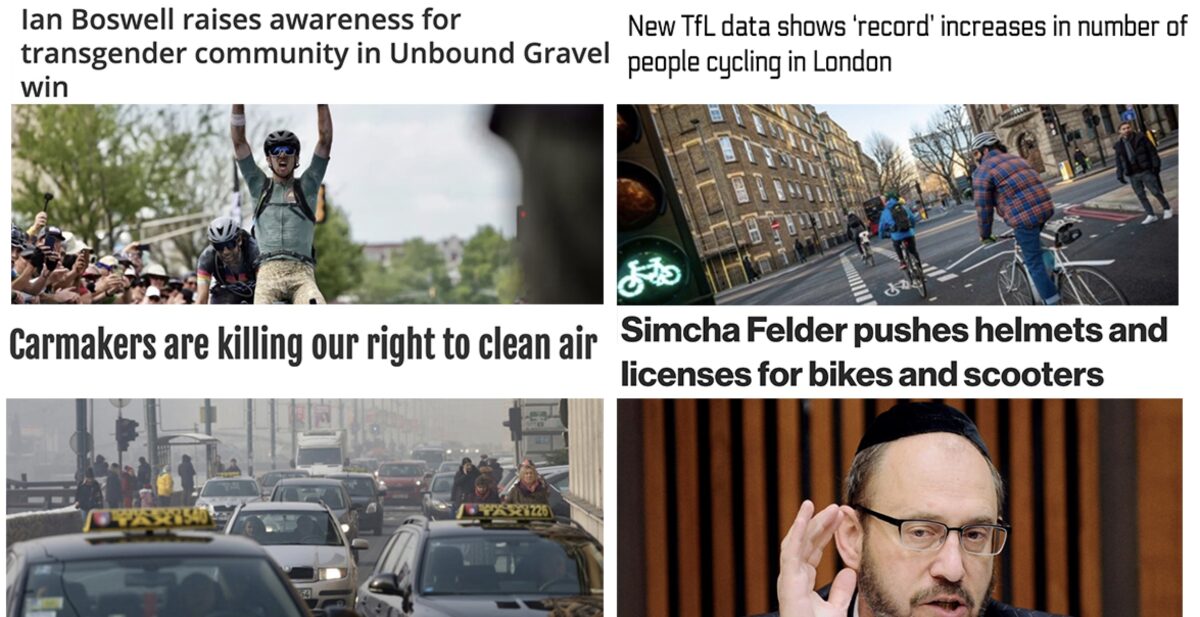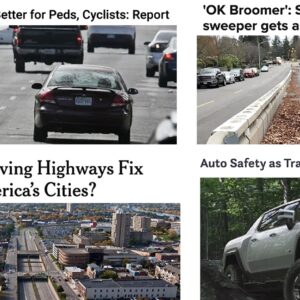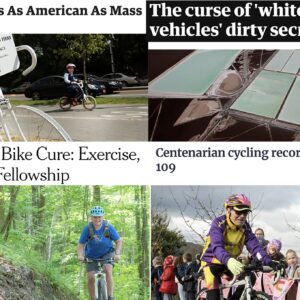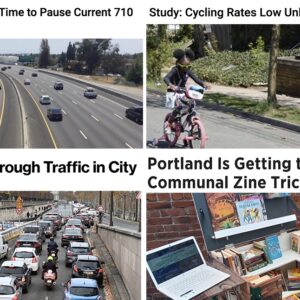Welcome to the week.
Here are the most notable items BikePortland editors and readers came across in the past seven days.
Transgender awareness boost: Pro bike racer Ian Boswell won a big gravel race Saturday and used the attention to raise awareness about discriminatory laws and other perils faced by transgender people.
Bike riders are like everyone else: People who ride bikes have different riding styles and they choose different types of vehicles and sometimes they disagree with each other about how fast they should go.
An e-bike for kids: You knew it was just a matter of time before kids bikes got the same battery-powered, electric assist option as adults.
What’s going on in DC?: Bookmark this excellent summary from Streetsblog about the federal transportation infrastructure funding plans.
Greenway stimulus: As the Biden Administration dangles billions over infrastructure funding, greenway advocates want to make sure their carfree corridors aren’t left by the side of the road.
Advertisement
I’ll have what London is having: Cycling is up in London thanks in part to a close partnership between city transportation planners and a major bike retailer who offers discounts for completion of a safety course.
Carmakers don’t care about you: A report from Europe details the craven concern trolling from a carmaker lobby that’s using women’s safety as a ruse to avoid tougher emission regulations.
WTH NYC?: The latest debate in New York is over licenses and helmets because a state senator almost killed someone with his car — and NYC Mayor de Blasio thinks it merits consideration.
House people, not cars: This CityLab piece on the “high cost of wide streets” offers important perspective for fights over how best to use them.
Video of the Week: An engrossing documentary about Portland’s unbuilt freeways.
— Jonathan Maus: (503) 706-8804, @jonathan_maus on Twitter and jonathan@bikeportland.org
— Get our headlines delivered to your inbox.
— Support this independent community media outlet with a one-time contribution or monthly subscription.








Thanks for reading.
BikePortland has served this community with independent community journalism since 2005. We rely on subscriptions from readers like you to survive. Your financial support is vital in keeping this valuable resource alive and well.
Please subscribe today to strengthen and expand our work.
If you were to just read the Boswell header, you would assume that he is transgender. He is not. I’m not sure what the ‘victory’ is that was referred to, other than the fact that Ian won the race.
Hi Steve,
I’m a news editor and my business is words. Sometimes I play with words to elicit a particular effect. In this case I think “transgender victory” works because the story it refers to is about transgender rights/issues and because Mr. Boswell’s victory in a race is what the story is all about. Also, it’s a “victory” for transgender people/rights/issue to get such huge PR exposure from a major race — regardless of the gender identity of the person who claimed the victory.
I knew that when I made my posting; bit of a stretch, I would say. Playing with words is risky business in journalism. It is one reason that so few of us believe what is published nowadays. What Ian (who I know and used to train with), did, was hand out some armbands before the race.
I’m sorry but I’m going to have to agree with Steve here. The fact that the victor happens to have a personal connection to a trans individual whom he supports and advocates rights for is important, but the fact is, it’s one thing to be cisgender and declare your support for trans rights in a public forum, and it certainly is honorable to do so; being trans and winning a race and having that pave the way for other transgender competitors is quite another matter. Of course, this is not to say that the onus is on transgender athletes to bring about a “transgender victory”, but I just don’t think that a cisgender ally himself winning constitutes such a victory.
While I appreciate that you’re highlighting stories related to trans rights, Steve and Aaron are right in that more nuance would be important here. Being an ally is about serving in a support role; allies are not people who themselves have “victories,” and real allies wouldn’t want to be described in that way. They are serving a larger cause.
Further, as a graduate student of strategic communication and multimedia journalism who’s in the thick of finals for a term that focused heavily on marketing, framing, and campaigns… I can definitively say that “awareness” is an insufficient goal for any campaign. Campaign objectives need to be more targeted than that to gain traction, and to ultimately garner results that will change the lives of trans people.
And finally, “orientation” is not the same as gender identity. This is a quick article on the difference. I hope it’s helpful! 🙂 https://www.glaad.org/how-sexual-orientation-different-gender-identity
Wow.
OK.
I figured using the word “victory” would be a fun way to present this story given that it hinges on a racing victory. But if it really is that problematic to folks, I will use a different word.
And thanks for that heads up about “orientation”. Very helpful. I wasn’t sure what to use there. Now I know!
Thanks for taking that into consideration! 🙂
Awareness boost is better phrasing. Thanks for listening!
Oregon Law says you have to be 16 years old to ride an ebike, motor assisted scooter (gas or electric), moped or segway. https://www.oregon.gov/ODOT/Forms/DMV/6619.pdf
Oregon law also says that kids must wear helmets. In Bend at least, the law is never, I mean never enforced. I was at the scene of a bike/car crash (low speed, no injuries). Cops called Mom, and the let the kids ride away on their BMX bikes, still not wearing helmets!! Most kids do wear helmets over here, probably 75%+, but that has nothing to do with law enforcement.
Regarding remnants of Portland’s unbuilt freeways, that is an excellent and timely video. It does, however, perpetuate two minor myths. First, the parking lots along the south side of SE Powell east of SE 50th were created after the Mt. Hood Freeway property acquisition had come to a halt, and are the result of one of the phases of widening Powell. Second, although Mt. Hood Freeway transfer money was a driving force for the political decision to build MAX, light rail was ultimately funded largely with Urban Mass Transportation Administration (now FTA) money, freeing up Mt. Hood transfer money for a variety of road projects around the Portland region. This switcheroo was enabled through Sen. Mark Hatfield’s seniority and power, following a change in federal law that allowed Interstate Transfer money to be used for local highways.
Not that I think it would pass, but if it did, would the Felder bill in NYC essentially ban all non-residents from riding bikes in the City because they could not get a license or register their bikes?
This is one of the major issues with any local jurisdiction requiring a license to ride a bike, or registration for bikes. Can you imagine if we had to do that to drive our cars in other cities or states?
In the days when I was a cycling officer in my local highways department, I had a discussion with a councillor about this. I pointed out that it would need to be a national policy, as riders from outside the city couldn’t be forced to follow purely local rules.
To make it national, the government would have to:
1. register all bikes which would be used on the road. This would, in turn, require identifying them (make, model, colour, etc.) All motor vehicles have a nationally sanctioned Vehicle Identification number (VIN). Bikes usually have a serial no. stamped on the frame,(under bottom bracket or on rear seat stay. However, many are unreadable (rusted off, filed off by thieves, etc. Some bikes make could not be identified (maker’s badge, name, etc., long since departed)
2. Having done this (10-20 million bikes to be registered, depending on their likely usage), the govt would have to assign number plates to them. These would have to be roughly equivalent in size to car no. plates, so that the bike could be identified in the case of a hit and run, ignoring red lights, wrong side of road riding, etc., etc. Question: Where would you put them. Car manufacturers are required to place area of vehicle at specific places for this purpose. Possible candidates: under saddle/on seatpost. Oh dear, bike too big for riders, so saddle slammed right down so no room because plate would be caught by tyre. Off-side seat stay? Could only be attached on one side – not too secure and 3 exposed edges potentially dangerous. I know, under cross bar – women’s bikes/ Dutch style city bikes? No x-bar. BMX? too small/low, ditto some mtbs and jump bikes. Front handlebars? Interfere with controls
3. Would need brand new number series UK system looks like ST05 UPD (05 is year 2005) Would need to be able to be flexible enough to deal with 3 million bikes/year sold in UK.
4. Would need to be on national database for police in-car Automatic Number Plate Recognition system to catch these vile miscreants. UK having national no. plate system cops system will automatically flag vehicles being driven without insurance, annual road tax or possible banned driver, etc.
5. Licence: most adult riders have driving licence so know rules of road – bit pointless really. However, in addition to massive increase in bureaucracy for registering bikes, also need ditto for testing riders
6. Insurance: even the notoriously law-abiding Swiss have abandoned this because the cost of running the scheme far outweighed the income from it and the amount of damage/injury caused by cyclists so minimal (by comparison with drivers), ludicrously out of balance with need.
7. The police would, naturally, be delighted in the increase in their workload in the drive to get these law breakers off the streets – they have so little to do otherwise.
By this time, the city councillor’s eyes had glazed over and he agreed that the idea had not been properly thought through.
I just love it when politicians propose legislation on the basis of a single incident which frightened them – must be wonderful to drive in a city where car drivers never do anything like that (them having number plates and proper driving licences and all).
Unfortunately the explanation of the lots along Powell is wrong. Some properties south of Powell had been acquired by ODOT for the Mt. Hood Freeway, and some that hadn’t been demolished were rented out by ODOT before being sold, but after the Mt. Hood Freeway was stopped, SE Powell was widened in two phases. The second phase, east of 50th, produced those parking lots. A full half-block width of land was acquired south of Powell for the widening along most stretches, because that is how wide the lots were, so the owners were fully bought out. That left surplus land, some of which was turned into parking lots to encourage commercial development on other parcels, if I remember correctly. The aerial photos on PortlandMaps.com show this between the 1975 photos, in which inner Powell has been widened, and the 1990 photos that show a widened outer Powell.
A second error on the video regards the portion of the MT. Hood Freeway east of I-205, which never going to run along the 2-lane portion of Powell but parallel to it about a half-mile south of it, along the Johnson Creek wetlands in an old railroad right of way in what is now the Springwater Corridor and parts of Foster. There’s still a parcel of industrial land in Lents called “Interstate Lands”. NE 148th was designed to be a major ramp for the freeway, which is why it is so absurdly wide, as was 162nd and 182nd. PBOT used to have all the old plans in their library – a fun read.